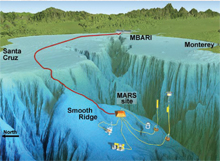An Extension Cord to MARS
 When completed, MARS will sit almost 3,000 feet before sea level in Monterey Bay
When completed, MARS will sit almost 3,000 feet before sea level in Monterey BayHigh-resolution version of this photo.
The oceans cover more than 70 percent of the planet's surface. Reaching a maximum depth of almost seven miles, they are home to an abundance of sea life, volcanoes and even mountain ranges that dwarf the Himalayas. We have only begun to unravel the mysteries of the deep, and may actually know more about the realms of space than about our own seas. But that may change thanks to copper and the debut of the Monterey Accelerated Research System (MARS), the first electrically powered deep-sea observatory located off the continental United States.
MARS is the brainchild of California's Monterey Bay Aquarium and Research Institute (MBARI). Funded by the National Science Foundation, MARS relies on a 32-mile "extension cord" using a copper sheath to provide electrical power for up to eight research experiments 2,923 feet below the surface of Monterey Bay.
WHY ALL THE ATTENTION NOW?
Most deep-water experiments are conducted far from land, but thanks to Monterey's unique geography, MARS is located relatively close to the shore. Still, a major problem faced by the engineers who designed the project was how to provide adequate, reliable power for its sophisticated electronic equipment. Batteries are used to power most underwater research electronics, but the location and depth of the MARS platform would make replacing batteries extremely difficult.
Another obstacle was how the scientists would collect information gathered by the equipment. Information would have to be stored and later retrieved, and real-time data collection would be impossible. The solution to powering the station was a technology that had been in use since the 1800s - an undersea electric copper cable.
Copper has been effectively used in underwater transmission cables for more than 150 years. The first permanent transatlantic telegraph cable laid in 1866 consisted of seven copper wires coated with a natural latex and surrounded by 18 strands of iron wiring for added strength and protection. Since then, the need for underwater electric and power transmission cables has grown exponentially. Today, underwater cable manufacturers almost exclusively rely on copper to meet their power transmission needs.
MARS TO THE RESCUE
MARS relies on a central science node which acts as an interface between the power cable and the experiments. The node contains eight Nautilus connection ports, the standard interface for ocean-based electronics, where each piece of electronics can plug-in for power and data transfer. Additional extension cables are in development to allow experiments to take place two miles away from the node. The first group of experiments for MARS will focus on four areas of study: climate change, food transport to deep sea, sounds in the sea and underwater earthquakes and landslides.
THE POWER OF COPPER
Slightly thicker than a garden hose, the cable was laid under the seafloor using traditional methods. The cable was placed three feet below the seafloor to reduce the possibility of entanglements with anchors and fishing nets. Once the cable was laid, it was attached to the science node using one of the MBARI Remote Operated Vehicles (ROV). The ROV will also be used to attach the experimental equipment to the science node.
The 32-mile cable is based on the design of cables used for long-haul submarine telecommunications. It consists of eight optical fibers for data transport inside a polybutylene terephthalate sheath surrounded by a layer of stranded high-strength steel wire. The strand of steel wires is encased inside a 0.65 millimeter copper tube or sheath that protects the data transfer components and, more importantly, conducts electricity. This bundle is encased in polyethylene insulation, protecting the components from water and electrical surges. The diameter of the entire cable is only 17 millimeters.
The protective and conductive copper sheath is made from 21 gauge, 100 percent virgin copper. The MARS cable will carry 10,000 Watts of electricity directly to the science node. The high voltage present minimizes power loss as electricity moves through the 52-km (32-mile) sea floor cable. Within the science node, transformers convert the high voltage to an instrument-friendly 375 or 48 volts of dc. By using high voltage in conjunction with a high-gauge copper, current is reduced, limiting the temperature and heat generated from resistance of the electrical flow in the copper. Approximately 50 lbs. of copper is used in the 32-mile cable.
CONCLUSION
Monterey Bay is one of the most biologically diverse waterways in the world, home to a variety of aquatic wildlife, and it is situated along the migratory path of Gray and Humpback whales. In addition, the California coast lies along an active continental plate. Millions of years of tectonic movement have created a shelf just a few miles offshore, where the ocean depth drops from a few fathoms to over 12,000 feet. With so many distinctive features, the Bay is an ideal locale for research into the ocean's geography and ecosystem.
With the cable now in place, testing is underway, and MARS is set to go online by the end of 2007. Scientists are now beginning to design the second wave of experiments which includes research into bioluminescence, chemosynthesis and wave flow. A new world awaits discovery, thanks to the "power" of copper. Cu
Resources:
Also in this Issue:
- The Serious Cook's Metal of Honor
- Keeping Copper Cookware Bright
- An Ancient Copper Treasure Map
- An Extension Cord to MARS
- The Scent of Cents
- Hiding Wires in Plain Sight
